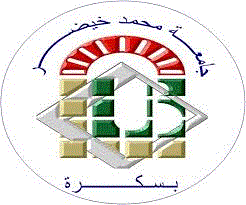| Titre : | Valorization of coffee grounds as fertilizer: Comparative study with the commercial fertilizer PNK. |
| Auteurs : | Siham ATAOUA, Auteur ; BOUKRAA ISSAM, Directeur de thèse ; Zineb BOULAKHRAS, Directeur de thèse |
| Editeur : | Biskra [Algérie] : Faculté des Sciences Exactes et des Sciences de la Nature et de la Vie, Université Mohamed Khider, 2024 |
| Format : | 1VOL.(96.p) / ill.couv.ill.en coul / 30cm |
| Langues: | Anglais |
| Langues originales: | Anglais |
| Mots-clés: | coffee grounds, durum wheat, soil, germination test, morphological parameters. |
| Résumé : |
The idea behind this research is considered to be one of the new techniques in biology for reducing the damage caused by chemical agriculture, whether to the soil, plants or humans. The study set out to measure the effect of fertilisation with dried coffee grounds on the acidity of this soil on the one hand; and on the other, to determine the response of durum wheat (Triticum durum Desf) to this type of biological fertilisation by studying several morphological characteristics, germination and growth tests and monitoring of essential element content in two periods (after one month's growth and at the end). The experimental plants were divided into Four groups on the basis of the doses of coffee grounds (coffee 1, coffee2, coffee++1 and coffee++2). A significant improvement in germination characteristics was also observed, as the results showed a significant effect on both the rate, speed and kinetics of germination. Morphological characteristics showed a significant increase in stem length, number of leaves and leaf area compared with the control. It was found that treatments with samples of coffee grounds doped with eggshells and banana peels had a positive effect on durum wheat, particularly in terms of morphology, as it showed good growth behaviour in terms of quantitative length, number of leaves and roots thanks to their nitrogen content and other useful minerals. |
| Sommaire : |
I.1. A brief history of fertilizers I.2. Definition of fertilizer I.3. Inorganic fertilisers I.3.1. Advantages of chemical inorganic fertilizer I.3.2. Disadvantages of Chemical fertilizer I.4. Organic fertilisers I.4.1. Advantages of Organic fertilizer I.4.2. Disadvantages of Organic fertilizer I.5. Fertilizers and the Environment I.5.1. The negative impact of excessive use of chemical fertilizers on the environment and humans I.5.1.1. For the environment I.5.1.2. on human beings I.5.2. Possible methods to reduce pollution by chemical fertilizers and toxic elements I.6. PNK fertilizer I.6.1. Definition I.6.2. Nitrogen fertilisers I.6.2.1. Definition I.6.2.2. the importance of nitrogen to the plant I.6.2.3. Effects of nitrogen deficiency in plants I.6.3. Phosphorus fertilisers I.6.3.1. Definition I.6.3.2. the importance of Phosphorus to the plant I.6.3.3. Effects of Phosphorus deficiency in plants I.6.4. Potassium fertilisers I.6.4.1. Definition I.6.4.2. the importance of Potassium to the plant I.6.4.3. Effects of Potassium deficiency in plants II.1. Waste II.1.1. Definition, Types, and Origin II.2. Valorization II.2.1. recycling and Types II.2.1.1. Material recycling II.2.1.2. Energy recycling II.2.1.3. Biological recycling (organic( II.3. Coffee II.3.1. Definition and Varieties II.3.2. Coffee preparation methods II.3.3. Chemical composition II.3.3.1. Carbohydrate content II.3.3.2. Lipid content II.3.3.3. Protein content II.3.3.4. Phenolic compounds II.3.3.5. Vitamins and minerals II.3.3.6. Other Constituents II.4. Coffee grounds II.4.1. Definition of coffee grounds II.4.2. Chemical Properties II.4.3. Areas of use for coffee grounds II.4.3.1. Energy and the production of biofuels II.4.3.2. Production of activated carbon II.4.3.3. Cosmetics and pharmaceuticals II.4.3.4. Food and Agricultural Industries II.4.3.5. Agriculture III.1. Durum Wheat. III.1.1.Definition of Wheat III.1.2.Plant morphology III.1.2.1. The root system III.1.2.2. The stem and Leaves III.1.2.3. fruit and flowers III.1.3.Wheat requirements III.1.3.1. Soil requirements III.1.3.2. Temperature requirements III.1.3.3. Water requirements III.1.3.4. Light requirements III.1.3.5. Fertilization requirements III.1.4.Wheat development cycle III.1.4.1. The vegetative period III.1.4.2. The reproductive period III.1.4.3. During the grain formation and ripening period III.1.5.Cultivation techniques III.1.5.1. Soil preparation III.1.5.2. Choice of Varieties III.1.5.3. Crop rotation III.1.5.4. Crop Installation III.1.6.The importance of Wheat cultivation III.1.6.1. In World-wide III.1.6.2. In Algeria III.2. Methods and Materials III.2.1.Analysis methods used III.2.1.1. Organic Matter OM III.2.1.2. Total carbon III.2.1.3. Kjeldahl nitrogen (N) III.2.1.4. Phosphorus (P2O5) dosage "Joret-Hebert method" III.2.1.5. Exchangeable base the cations K+ in soil III.2.2. Equipment used III.2.2.1. The soil III.2.2.2. Irrigation process III.2.2.3. Plant material III.2.3.Design of the experiment III.2.4.Carrying out the experiment III.2.4.1. Experiment Steps III.2.5.Readings taken at the study site 1) The germination a. Final germination rate G (%) b. Germination kinetics c. Germination speed d. Average daily germination (MDG = Mean Daily Germination) 2) Growth study: Morphological parameters a. Length kinetics b. Leaf number kinetics c. Leaf area d. length of above-ground, root and total parts III.3. The organic soil improvers used 00 III.4. Monitoring of Germination 00 III.4.1.Effect of coffee grounds on germination rate III.4.2.The effect of coffee grounds on the kinetics of wheat germination III.4.3. The effect of coffee grounds on the germination rate of durum wheat III.4.4. Effect of coffee grounds on mean daily germination (MDG) of durum wheat III.5. Monitoring of growth III.5.1.Effect of coffee grounds on the kinetics of durum wheat root length III.5.2.Effect of coffee grounds on the aerial part of durum wheat III.5.3.Leaf area S III.5.4.Effect of coffee grounds on the total leaf area of durum wheat III.5.5.Discussion III.6. Monitoring of elements III.6.1. Discussion of element content results. III.6.1.1. Organic matter and C/N ratio. III.6.1.2. The mineral content of the samples |
| Type de document : | Mémoire master |
Disponibilité (1)
| Cote | Support | Localisation | Statut |
|---|---|---|---|
| MCH/652 | Mémoire master | bibliothèque sciences exactes | Consultable |





